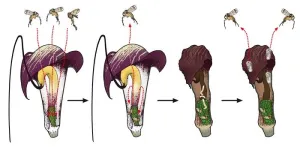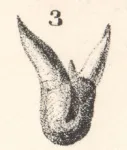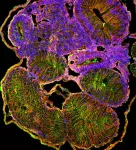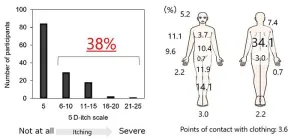(Press-News.org) Dopamine, a chemical messenger in the brain, is mostly known for its role in how we experience pleasure and reward. However, new research from the Champalimaud Foundation (CF) shifts the spotlight towards dopamine’s critical involvement in movement, with implications for our understanding and treatment of symptoms in Parkinson’s Disease (PD).
Imagine the act of walking. It’s something most able-bodied people do without a second thought. Yet it is actually a complex process involving various neurological and physiological systems. PD is a condition where the brain slowly loses specific cells, called dopamine neurons, resulting in reduced strength and speed of movements. However, there’s another important aspect that gets affected: the length of actions. Someone with PD might not only move more slowly but also take fewer steps in a walking sequence or bout before stopping. This study shows that dopamine signals directly affect the length of movement sequences, taking us a step closer to unlocking new therapeutic targets for enhancing motor function in PD.
“Dopamine is most closely associated with reward and pleasure, and is often referred to as the ‘feel-good’ neurotransmitter”, points out Marcelo Mendonça, the study’s first author. “But, for dopamine-deficient individuals with PD, it’s typically the movement impairments that most impact their quality of life. One aspect that has always interested us is the concept of lateralisation. In PD, symptoms manifest asymmetrically, often beginning on one side of the body before the other. With this study, we wanted to explore the theory that dopamine cells do more than just motivate us to move, they specifically enhance movements on the opposite side of our body”.
Shedding Light on the Brain
To this end, the researchers developed a novel behavioural task, which required freely-moving mice to use one paw at a time to press a lever in order to obtain a reward (a drop of sugar water). To understand what was happening in the brain during this task, the researchers used one-photon imaging, similar to giving the mice a tiny, wearable microscope. This microscope was aimed at the Substantia nigra pars compacta (SNc), a dopamine-rich region deep within the brain that is significantly impacted in PD, allowing the scientists to see the activity of brain cells in real-time.
They genetically engineered these mice so that their dopamine neurons would light up when active, using a special protein that glows under the microscope. This meant that every time a mouse was about to move its paw or succeeded in getting a reward, the scientists could see which neurons were lighting up and getting excited about the action or the reward.
Observing these glowing neurons, the discoveries were, quite literally, illuminating. “There were two types of dopamine neurons mixed together in the same area of the brain”, notes Mendonça. “Some neurons became active when the mouse was about to move, while others lit up when the mouse got its reward. But what really caught our attention was how these neurons reacted depending on which paw the mouse used”.
How Dopamine Chooses Sides
The team noticed that the neurons excited by movement lit up more when the mouse used the paw opposite to the brain side being observed. For example, if they were looking at the right side of the brain, the neurons were more active when the mouse used its left paw, and vice versa. Digging deeper, the scientists found that the activity of these movement-related neurons not only signalled the start of a movement but also seemed to encode, or represent, the length of the movement sequences (the number of lever presses).
Mendonça elaborates, “The more the mouse was about to press the lever with the paw opposite the brain side we were observing, the more active neurons became. For example, neurons on the right side of the brain became more excited when the mouse used its left paw to press the lever more often. But when the mouse pressed the lever more with its right paw, these neurons didn’t show the same increase in excitement. In other words, these neurons care not just about whether the mouse moves, but also about how much they move, and on which side of the body”.
To study how losing dopamine affects movement, the researchers used a neurotoxin to selectively reduce dopamine-producing cells on one side of a mouse’s brain. This method mimics conditions like PD, where dopamine levels drop and movement becomes difficult. By doing this, they could see how less dopamine changes the way mice press a lever with either paw. They discovered that reducing dopamine on one side led to fewer lever presses with the paw on the opposite side, while the paw on the same side remained unaffected. This provided further evidence for the side-specific influence of dopamine on movement.
Implications and Future Directions
Rui Costa, the study’s senior author, picks up the story, “Our findings suggest that movement-related dopamine neurons do more than just provide general motivation to move - they can modulate the length of a sequence of movements in a contralateral limb, for example. In contrast, the activity of reward-related dopamine neurons is more universal, and doesn’t favour one side over the other. This reveals a more complex role of dopamine neurons in movement than previously thought”.
Costa reflects, “The different symptoms observed in PD patients could be perhaps related to which dopamine neurons are lost—for instance, those more linked to movement or to reward. This could potentially enhance management strategies in the disease that are more tailored to the type of dopamine neurons that are lost, especially now that we know there are different types of genetically defined dopamine neurons in the brain”.
END
One step forward, no steps back: new study advances understanding of dopamine’s role in movement
2024-02-19
ELSE PRESS RELEASES FROM THIS DATE:
Pollinator's death trap turns into nursery
2024-02-19
In a group of plants that is famous for luring its pollinators into a death trap, one species offers its flowers as a nursery in exchange. The Kobe University discovery blurs the line between mutualism and parasitism and sheds light on the evolution of complex plant-insect interactions.
Many plants rely on animals for pollination and most offer rewards for the service. Some plants, however, deceive their pollinators, and a famous example is the genus Arisaema. “It is famous as the only plant that achieves pollination at the expense of the pollinator's life,” says Kobe University biologist SUETSUGU Kenji, who is an expert on plant pollination ecology. The plant uses ...
Studies find flu vaccines were effective in 2022-2023 flu season
2024-02-19
The prospect of the worrisome triple threat of COVID, RSV and flu was assuaged last year by the effectiveness of flu vaccines. Two recent studies from the Centers for Disease Control and Prevention’s VISION Network have found that flu vaccines were effective for all ages against both moderate and severe flu in the U.S. during the 2022-2023 flu season.
Both the pediatric and adult VISION Network studies analyzed flu-associated emergency department (E.D.)/urgent care visits (indicative of moderate disease) and hospitalization (indicative of severe disease) from October 2022 through March 2023, a flu season in which far fewer individuals were social distancing or ...
Second year of Cal Poly astronomy fellowship to examine high-energy particle jets near supermassive black holes
2024-02-19
February 16, 2024
Contact: Nick Wilson
805-235-8008; nwilso28@calpoly.edu
Second Year of Cal Poly Astronomy Fellowship to Examine High-Energy Particle Jets Near Supermassive Black Holes
SAN LUIS OBISPO — In the second year of the Astronomy Faculty Research Fellowship in Cal Poly’s Bailey College of Science and Mathematics, a research team will study extremely high-energy photons emitted by the extreme environment found near mega-sized black holes.
The fellowship was ...
To boost a preschooler’s language skills, consider reminiscing
2024-02-19
Language skills are strong predictors of academic, socioemotional and behavioral outcomes when children enter school. They learn language in preschool years by interacting with others, especially their parents. Book sharing is a popular way parents engage young children in conversation. However, not all parents are comfortable with book sharing and not all children like having books read to them.
A new study on “parent talk” by Florida Atlantic University, in collaboration with Aarhus University in Denmark, provides ...
Husker team wins prize in contest to treat disease through gene editing
2024-02-19
Lincoln, Nebraska, Feb. 19, 2024 — A Husker research duo was named a first-round winner in a National Institutes of Health competition aimed at generating solutions for delivering genome-editing technology to the cells of people with rare and common diseases.
Janos Zempleni, Willa Cather Professor of molecular nutrition, and Jiantao Guo, professor of chemistry, were selected as Phase 1 winners in the NIH’s Targeted Genome Editor Delivery Challenge. The challenge is a three-phase competition with prizes totaling $6 million; the University of Nebraska–Lincoln team was among 30 initial recipients announced in December ...
Why two prehistoric sharks found in Ohio got new names
2024-02-19
COLUMBUS, Ohio – Until recently, Orthacanthus gracilis could have been considered the “John Smith” of prehistoric shark names, given how common it was.
Three different species of sharks from the late Paleozoic Era – about 310 million years ago – were mistakenly given that same name, causing lots of grief to paleontologists who studied and wrote about the sharks through the years and had trouble keeping them apart.
But now Loren Babcock, a professor of earth sciences at The Ohio State University, has finished the arduous task of renaming two of the three sharks – and in the process rediscovered a wealth ...
Study reveals five common ways in which the health of homeless pet owners and their companions is improved
2024-02-19
A rapid scoping review has been conducted which reveals five common ways in which the health of homeless pet owners and their companion animals is improved.
Ten percent of homeless people keep pets. But little information exists on specific intervention strategies for improving the health of homeless people and their pets who are often the only source of unconditional love or companionship in their life.
The study, published in the Human-Animal Interactions journal, found that the most common ways ...
Potassium depletion in soil threatens global crop yields
2024-02-19
Potassium deficiency in agricultural soils is a largely unrecognised but potentially significant threat to global food security if left unaddressed, finds new research involving researchers at UCL, University of Edinburgh and the UK Centre for Ecology & Hydrology.
The study, published in Nature Food, found that more potassium is being removed from agricultural soils than is being added, throughout many regions of the world. It also gives a series of recommendations for how to mitigate the issue.
Potassium is a vital nutrient for plant growth that ...
Poorly coiled frog guts help scientists unravel prevalent human birth anomaly
2024-02-19
How does our intestine, which can be at least 15 feet long, fit properly inside our bodies? As our digestive system grows, the gut tube goes through a series of dramatic looping and rotation to package the lengthening intestine. Failure of the gut to rotate properly during development results in a prevalent, but poorly understood, birth anomaly called intestinal malrotation. Now, in a study published in the journal Development, scientists from North Carolina State University have uncovered a potential cause of this life-threatening condition.
Intestinal malrotation affects 1 in 500 births but the underlying causes are not well understood. ...
Unveiling uremic toxins linked to itching in hemodialysis patients
2024-02-19
Niigata, Japan – Dr. Yamamoto et al. found the several uremic toxins as one of causes of itching in hemodialysis patients. Hemodialysis patients commonly experience itching on a daily basis, which is distributed throughout their bodies. They developed a "PBUT score" based on highly protein-bound uremic toxins (PBUT) that increase in the body with end-stage kidney disease. The PBUT score was associated with itching in hemodialysis patients.
I. Background of the Study
Patients with advanced chronic kidney disease (CKD) require kidney replacement therapy, such as hemodialysis, to manage their condition. Hemodialysis patients often experience various symptoms, ...






